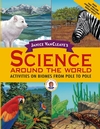Notes from Janice’s Desk
I’ve been thinking of all the different geographical regions of the world that I’ve had an opportunity to visit. The geographic South Pole in Antarctica was the most difficult to get to as well as being a difficult place to visit. Not only was it cold but the altitude was about 9, 300 ft (2790 m). When preparing for this science trip, I was instructed to make detailed notes of what I wanted to do each day. This was because at such a high altitude, it would take longer than my scheduled visiting time for my body to adjust to the altitude. Altitude sickness included muscle aches as well as difficulty in thinking and I experienced both. But since I have fibromyalgia, the muscles aches were just intensified. As to not being able to think–well I didn’t really notice this until I got lost walking from one building to another and visibility was perfect. I felt like I was having a bad dream. For details of this adventure, see LOST AT THE POLE.
It was summer time at the pole so with wind chill the temperature was about -50 degrees C (-58 degrees F). For a gal from Central Texas, this was bone chilling cold.
Kids from around the world had an opportunity to be part of my pole adventure. Prior to leaving, kids and educators supplied questions and ideas for experiments. I collected information and via email sent data to a person who posted it on a website that was active at that time. One thing that I found very interesting was that the ice sheet at the pole moved toward the edge of the continent at a rate of about 10 meters per year. See Janice At the South Pole Marker for information about how this shift affected the location of the pole marking the location of the Geographic South Pole.
More Later,
Janice
Science Around the World
This book presents interesting facts and fun experiments that relate to the different geographical regions of the world-also known as biomes. Each different biome-forest, grassland, desert, and tundra-has its own unique plant life, animal life, and climate. The experiments, activities, and facts in this book help explain how the different biomes work and show the importance biomes play in keeping life on Earth so fascinatingly diverse.
(Paid Link)
